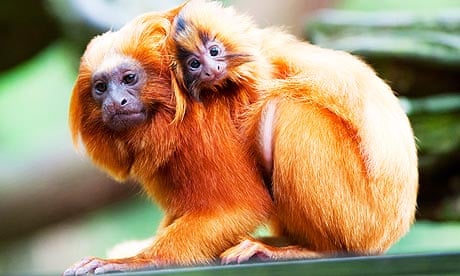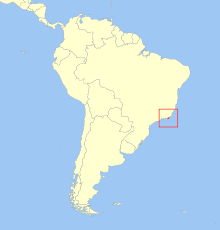Source: Google Images
|
Physiology:
The golden lion tamarin belongs to the family callitrichidae, a group of new world monkeys that includes marmosets and tamarins. It is the largest of the callitrichines, weighing in at approximately 1.3 pounds and the length of their body being somewhere between six and ten inches, not including the ten to sixteen inch tail. They get their name from the distinctive reddish gold hairs that surround their face and ears, creating a brilliant mane around their dark, hairless face. The golden color of their hair is thought to be caused by the sunlight and the organic pigments found in their food. Unlike old world monkeys and apes, who have flat finger and toe nails, the golden lion tamarin and all other new world monkeys have tegulae (1), small claw-like nails that allows the monkey to easily cling to the bark of trees and branches. Their sharp claws, combined with their prehensile tail, are the monkeys mode of transportation, allowing them to quickly travel among the branches in which they live, jumping from tree to tree, and even running, squirrel-like, through the treetops. Golden lion tamarins are not sexually dimorphic, so both male and the female monkeys are both relatively the same size and color.
Behavior:
In the wild, golden lion tamarins live in groups of two to eleven, with the average group number ranging around five. However, average group sizes have decreased in recent years due to high levels of predation. The social structure of the group varies, but always includes one dominant male and female breeding pair. Most dominant males are monogamous, breeding with only one female, but occasionally they will exhibit polygamous behavior and breed with two females, usually a mother/daughter pair. In addition to the ruling pair, there will be several subadult, juvenile, and infant members of the group that are usually offspring of the dominant breeding pair. If there is more than one adult male in the group, one asserts his dominance over the other via physical violence and by
 |
| Source: The Guardian |
Ecology:
Golden lion tamarins are omnivorous, eating everything from fruits and flowers to birds eggs, insects, and small vertebrates. Although much of their original habitat has been destroyed, small microhabitats exist within their current range, including bromeliads, vine tangles, and rotting logs, that are important to the monkeys' foraging habits and living patterns. The tamarins use their elongated fingers to catch small prey hiding in crevices and underneath leaves. Insects, however,only make up approximately 15% of their diet, while a considerably larger portion of their diet consists of fruit, found in the leafy tree tops. During the dry season, when fruit and insects are not as abundant, they must rely on other sources of food, such as nectar, gum, and small animals, usually reptiles.
| Source: Flickr |
Habitat and Distribution:
The golden lion tamarin is native to the rain forests of Eastern Brazil, specifically, the Atlantic Coastal Forest. Because of deforestation, they have lost all but approximately 5% of their original habitat and are now limited to three specific areas, Poço (POH-so) das Antas Biological Reserve, Fazenda União Biological Reserve, and some private land through the Reintroduction Program. In Poço das Antas (5), they prefer swamp jungle, situated no more than 300 ft. above sea level, which contains many vines, bromeliads, and a high density of both fruit and animal food sources. Because
 |
| Source: Wikipedia |
all of this land originally fell victim to the logging industry, it is not as it once was, so it is not well known what the monkeys preferred before they were thrust into that situation. It is assumed that they preferred a humid, closed canopy forest with a large amount of vegetation that would provide pathways through the trees and protection from airborne predators. A population estimate back in 1972 decided that there were approximately between 400 and 500 golden lion tamarins in the wild. A more recent count in 1981 determined the number to be less than 200 and an even more recent estimate has found that numbers have increased to be, at most, 400 individuals (2).
Conservation:
The golden lion tamarin was first placed on the endangered species list by the International Union for Conservation of Nature (IUCN) in 1982. Not long after, in 1984, the National Zoological Park in Washington D.C. and the World Wide Fund for Nature (WWF) started a reintroduction program through the Golden Lion Tamarin Association. This program enlisted the help of 140 zoos, worldwide, to breed and reintroduce golden lion tamarins back into the wild in order to boost wild populations. Despite the success of this project, the IUCN increased the level of endangerment to critically endangered in 1996. Deforestation, illegal poaching, and urbanization are some of the main reasons that there has been such a sharp decline in numbers. However, organizations, such as the Nation Zoo, has worked diligently to help bring these numbers back up, through specialized breeding programs, reintroduction, and translocation. By increasing the wild populations by reintroduction and maintaining large breeding groups in captivity, the conservation efforts have succeeded. However, deforestation and poaching are still fierce competitors and the battle is continual (1).
Works Cited:
- Golden lion tamarin. (2014, November 30). Retrieved December 2, 2014, from http://en.wikipedia.org/wiki/Golden_lion_tamarin
- About Golden Lion Tamarins - National Zoo| FONZ. (n.d.). Retrieved December 2, 2014, from http://nationalzoo.si.edu/SCBI/EndangeredSpecies/GLTProgram/Learn/
- Golden lion tamarinLeontopithecus rosalia. (n.d.). Retrieved December 2, 2014, from http://pin.primate.wisc.edu/factsheets/entry/golden_lion_tamarin
- Lapenta, M. J., De Oliveira, P. P., Kierluff, M. C., & Motta-Junior, J. C. (2003). Fruit exploitation by golden lion tamarins (leontopithecus rosalia) in the uniao biological reserve, rio das ostras, rj - brazil. Mammalia. Retrieved from http://www.micoleao.org.br/arquivos/artigos/Lapenta%20et%20al_2003.pdf
- Leontopithecus rosalia. (n.d.). Retrieved December 8, 2014, from http://www.iucnredlist.org/details/11506/0
No comments:
Post a Comment